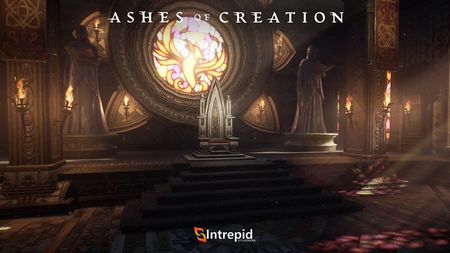Economic regions
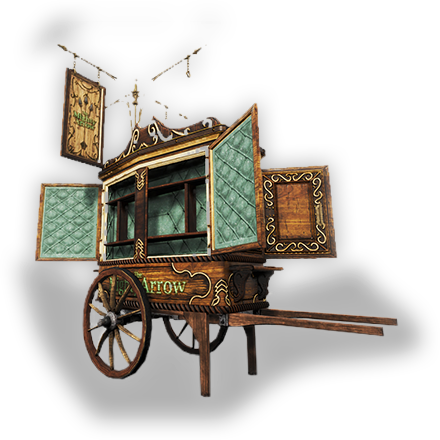
We want our players to have a reason to explore the wilderness, to travel with purpose, and much of that will be driven by our resource system. Transporting these goods might just be more difficult than gathering them. Our regional market system allows players to participate in creating pocket economies that will reinforce the stability of goods in particular regions. Players will be able to move resources and set up shop in other areas to take advantage of the varied markets. With resources spawning dynamically, certain regions will naturally become important trading hubs for the transportation of goods throughout the world.[1]
Economic regions are static areas defined by geographic points of interest.[2][3][4]
- Castle regions are larger and encompass multiple economic regions.[2]
- Nodes are the glue that hold castle and economic regions together in potential synergy or chaos.[5]
- Castle regions, Economic regions, and Node ZOI (Zones of Influence) can overlap.[6]
The whole map would be under the influence of 1 of 5 castle regions. However, castle regions aren't the only TYPE of region - there are also economic regions, among other things.[3] – Sarah Flanagan
Castle regions
Guild castles influence a castle region around them.[7]
- A castle's region is 1/5th the game world.[8]
- Castle regions, Economic regions, and Node ZOI (Zones of Influence) can overlap.[9][6]
- A castle could have a metropolis beside it.[10]
- Castle region boundaries are static.[9]
- Guild castles impose a tax on all revenue for the nodes within its region.[11][12]
Castle taxes
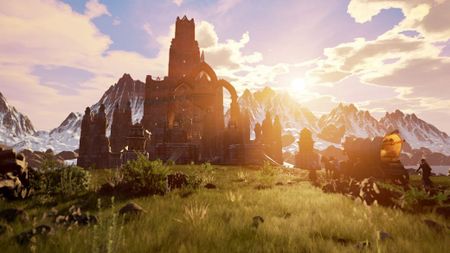
Castles have direct power over the Nodes that belong to it, but also have soft power across the entire region it belongs to. All Nodes belonging to that region pay fealty to the Castle in the form of taxes paid directly to the Castle. The Monarch sets the rate, and can use those proceeds to upgrade defenses, maintain the Castle’s direct Nodes, or provide buffs and benefits to the citizens of that region, as the magnanimous ruler that you are.[13]
Guild castles impose a tax on all revenue for the nodes within its region.[11][12]
- The monarch sets the tax rate, and can use those proceeds to upgrade defenses, maintain the castle's direct nodes, or provide buffs and benefits to the citizens of that region.[13]
- Castle taxes are carried via NPC generated caravans from the nodes that fall under the castle's purview to one of the castle nodes at the end of each week leading up to a castle siege.[14]
- In addition to taxes, Castles also influence crop yields, resources and events within its region.[15]
- Part of the tax and resources gathered are applied to the castle for improvements.[11][16][17]
- The remainder of tax income can be used by the guild for whatever they want.[11][18]
- When castles change hands (following a siege), some taxes stay with the castle and some stay with the guild.[19]
- Castles have the ability to allocate taxes collected from nodes under them toward certain benefits that go back to the node. Or they can be more selfishly governed that treasury more towards the guild that owns it and that obviously is going to have some political implications, because it could- if you're not using it for the benefit of the people in the region they might rise up and help take you out from that that position of owning that castle.[11] – Steven Sharif
Resource locations
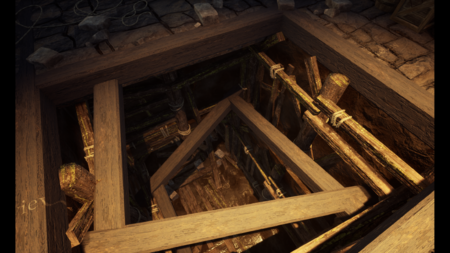
Players will be able to move resources and set up shop in other areas to take advantage of the varied markets. With resources spawning dynamically, certain regions will naturally become important trading hubs for the transportation of goods throughout the world.[1]
The location a resource is found can affect its benefits, bonuses, and other characteristics of that resource.[21]
- Lower level resources will be abundant. Higher level resources that are gatherable by Apprentice level or higher artisans will spawn randomly but in places that make sense for that type of resource. Surveying is a mechanic that solo or group players can utilize to track these resources down.[22][23][24]
- Some resources will exist as a cluster (also called vein gatherables). These will last until the full resource is depleted.[25][23][24][26][4]
- Like a large mine that's present and has a vein of mithril ore in it, or a herd of some type of animal that you can collect fur or wool from.[24] – Steven Sharif
- Once a vein resource is depleted from one location it may respawn in the same location or somewhere else, depending on the type of resource.[24][26][27]
- There will be moving resources such as herds of animals that are constantly moving around the world.[25][27]
- Herds are a source of certain types of wild gatherables but they're in animal form and they're animated; and they exist in a group of the golden fleece sheep that might only spawn very rarely in certain hillsides; and only during spring. And if you can find that vein so to speak of resource you can interact with the herd and you can gather from them.[25] – Steven Sharif
- Corrupted areas house corrupted resources that are necessary components for certain crafting recipes.[28][29]
- Certain types of resources will have a corrupt state... We have a Spirit Bloom, which is a harvestable herbalism plant, but when a Zone becomes corrupt you can potentially yield Corrupted Spirit Blooms; and those are necessary components of certain crafting recipes.[28] – Steven Sharif
- Resources respawn on a cooldown basis.[26]
- Resources won't be locked to the node system.[26]
- Starting resource points may be different on each server.[31][32]
Trade agreements
Mayors can enter into trade agreements with other nodes to facilitate trade between the nodes.[33][34][35]
- There are a limited number of trade agreements that a node can have.[33]
- Mayoral caravans may only be initiated between nodes with trade agreements or alliances.[33][34]
- Trade agreements affect reputation between the nodes.[36][37]
- Mercenary guilds will be a viable way forward for different organizations. I think there will be a lot of business to be had with that; and one of the systems in our trade agreements is creating an escrow for those particular type of arrangements that we're looking into.[38] – Steven Sharif
Trade routes
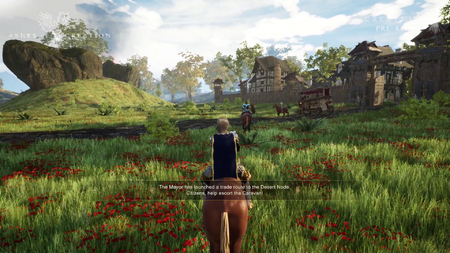
For example: this node over here might have access to cotton as a resource and when that node processes that cotton it might be some very nice type of linen that only that node, or very rarely nodes would have access to. So when you initiate a trade route, you're bringing its supplies that the mayor has requested because they're trying to build, let's say a specific type of service building, or they're trying to unlock a blueprint that they have access to now to build up their node.[39] – Steven Sharif
Trade routes in Ashes of Creation refer to.
- Roads for the transit goods via the caravan system.[40]
- You might have a mountain pass and during winter that mountain pass is always closed and so the trade routes on land change with caravans and that's something that can not only exist on a cyclical level but also dynamically based on player activity.[40]
- Economic relationships between nodes established by Mayors or node citizens.[39][34]
- Agreements are established to trade commodities that are unique to particular nodes or node types via NPC-driven caravans.[39][34]
- From a diplomatic standpoint the ability for the mayor or citizens to set up NPC routed trade routes between nodes as a trade agreement or as a diplomatic process.[39] – Steven Sharif
See also
References
- ↑ 1.0 1.1 About Ashes of Creation.
- ↑ 2.0 2.1 2.2

- ↑ 3.0 3.1

- ↑ 4.0 4.1 Unreal Engine Interview, 2017-05-23.
- ↑

- ↑ 6.0 6.1
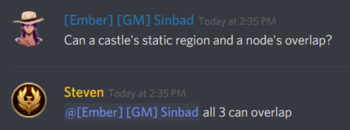
- ↑

- ↑

- ↑ 9.0 9.1

- ↑
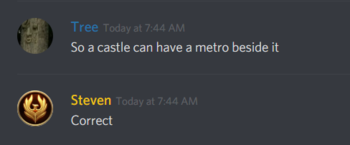
- ↑ 11.0 11.1 11.2 11.3 11.4 Livestream, April 30, 2021 (1:01:10).
- ↑ 12.0 12.1

- ↑ 13.0 13.1 Blog: 10 facts about castle sieges in the MMORPG.
- ↑ Livestream, August 28, 2020 (1:39:02).
- ↑

- ↑

- ↑

- ↑

- ↑

- ↑
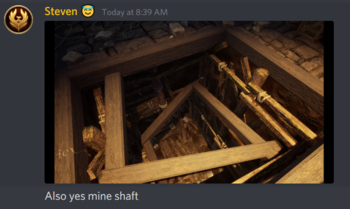
- ↑ Livestream, April 28, 2023 (1:24:36).
- ↑ Video, November 30, 2023 (28:22).
- ↑ 23.0 23.1 Livestream, July 31, 2020 (1:05:58).
- ↑ 24.0 24.1 24.2 24.3 Livestream, July 25, 2020 (1:04:50).
- ↑ 25.0 25.1 25.2 Livestream, May 27, 2022 (1:00:23).
- ↑ 26.0 26.1 26.2 26.3 Livestream, May 8, 2017 (54:26).
- ↑ 27.0 27.1 Livestream, December 17, 2019 (1:14:42).
- ↑ 28.0 28.1 Livestream, March 31, 2023 (59:10).
- ↑ Video, March 31, 2023 (16:42).
- ↑
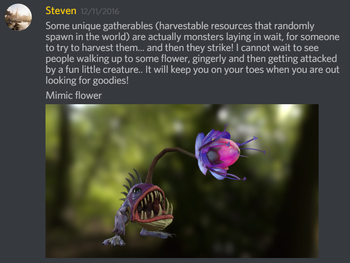
- ↑

- ↑ Livestream, May 19, 2017 (37:03).
- ↑ 33.0 33.1 33.2 Livestream, August 31, 2023 (2:10:23).
- ↑ 34.0 34.1 34.2 34.3 34.4 Video, July 15, 2019 (2:12).
- ↑ City hall.
- ↑ Blog: Development Update with Village Node.
- ↑ Livestream, August 31, 2023 (44:21).
- ↑ Livestream, 2018-04-8 (AM) (18:59).
- ↑ 39.0 39.1 39.2 39.3 Podcast, September 29, 2021 (8:38).
- ↑ 40.0 40.1 Video, May 27, 2022 (17:15).
- ↑ Livestream, May 17, 2017 (30:53).
- ↑ Kickstarter - We Just Broke $1,500,000!
